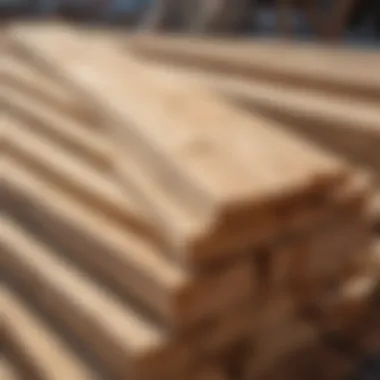Innovations in Laminated Lumber for Sustainable Forestry


Overview of Forestry Practices
Forestry encompasses a variety of practices centered around the management, conservation, and restoration of forests. It is essential not only for maintaining biodiversity but also for supporting ecological processes. The definition of forestry includes the sustainable management of forests, tallied with the cultivation of trees for timber, recreation, and habitat restoration.
Importance of Forestry in Ecosystem Management
Forestry plays a pivotal role in ecosystem management by promoting balanced interactions between natural resources and biodiversity. Through responsible practices, forestry helps mitigate climate change by capturing carbon dioxide from the atmosphere and enhancing soil health. The sustainable management of forest resources leads to healthier ecosystems, thereby securing water sources, preventing soil erosion, and preserving habitats for countless species.
Sustainable Forest Management
Sustainable practices in forestry advocate for a balanced approach that considers economic viability, environmental health, and social equity.
Principles of Sustainable Practices
The principles of sustainable forest management focus on maintaining the ecological integrity while using forest resources. Key principles include:
- Conservation of Biodiversity: Protecting and maintaining a diverse range of species and ecosystems.
- Resource Efficiency: Utilizing resources in a manner that ensures their availability for future generations.
- Community Engagement: Involving local communities in decision-making processes to promote responsible use of forest areas.
Techniques in Sustainable Management
Sustainable management techniques help to achieve the goals of forestry. Some of these techniques include:
- Selective logging, which minimizes environmental impact.
- Reforestation efforts to restore depleted areas.
- Agroforestry, integrating trees and shrubs into agricultural landscapes to improve productivity and biodiversity.
Woodland Stewardship Strategies
Woodland stewardship is a critical aspect of forestry that emphasizes responsible management of forested areas.
Importance of Woodland Stewardship
Stewardship ensures that forests remain healthy and vibrant for future generations. By taking a proactive approach, landowners can make informed decisions that promote the longevity of their forests and contribute to ecological health.
Best Practices for Landowners
Landowners can adopt several best practices to enhance their woodland management efforts. These include:
- Regular assessment of forest health, including monitoring for pests and diseases.
- Implementing a management plan that outlines specific goals, such as biodiversity enhancement and timber production.
- Collaboration with forestry professionals to optimize land use and resource management.
"Effective forest management is not solely about timber production; it is about preserving ecosystems for future generations."
Through understanding these foundational concepts, the role of laminated lumber in forestry emerges as increasingly significant. It exemplifies advancements in sustainable construction practices, ultimately benefiting both the environment and economy.
Prologue to Laminated Lumber
Laminated lumber has emerged as a significant material in modern forestry and construction. This innovative wood product enhances the structural capabilities of timber while addressing sustainability concerns in various applications. The composition and manufacturing of laminated lumber allow for the utilization of smaller timber pieces, promoting a more efficient use of available forest resources. Understanding its importance requires a closer look at its definition, components, and historical development.
Definition and Components
Laminated lumber, often referred to as engineered wood, consists of layers of wood glued together to create a solid structural product. The layers can be made of solid wood or veneer, and they are aligned in a specific manner to optimize strength. The main components include the adhesive used for bonding, the type of wood selected for layers, and the finished dimensions of the product. The adhesive plays a crucial role in determining the durability and performance of the lumber.
The most common types of laminated lumber include glue-laminated timber, cross-laminated timber, and laminated veneer lumber. Each of these variants utilizes different wood layer arrangements and adhesive techniques, which serve particular engineering and construction needs. As the demand for sustainable and versatile building materials increases, so does the relevance of laminated lumber in contemporary architecture and structural engineering.
Historical Development
The historical evolution of laminated lumber is rooted in the need for stronger and more resource-efficient building materials. Initially developed in the early 20th century, the technology saw gradual advancements throughout the decades. Glue-laminated timber first gained popularity in Europe, with structures like the newly constructed bridges indicating its potential. The innovative combination of wood and adhesive was recognized for its capability to channel the natural properties of timber in a new form, thus expanding its use beyond traditional applications.
As the construction industry faced challenges in sourcing high-quality timber, laminated lumber provided an alternative that made better use of local wood sources. Over the years, ongoing research and improvements in adhesive technologies have further enhanced the performance and application scope of laminated lumber, establishing it as a pillar in sustainable building practices. Modern applications, including large-scale structures like commercial buildings and bridges, are testaments to its durability and flexibility.
"Laminated lumber is not just a trend; it represents a crucial shift towards sustainable and efficient forestry practices."
In summary, laminated lumber's importance lies in its structural efficiency and ability to support sustainable forestry initiatives. This section lays the groundwork for understanding the manufacturing processes that contribute to its widespread use and the innovations that continue to shape its applications in the forestry and construction industries.
Manufacturing Processes of Laminated Lumber
Manufacturing processes of laminated lumber are fundamental in determining both the quality and applicability of the product. Understanding these processes enables professionals to appreciate how laminated lumber can serve a variety of roles in construction and design. Each stage in production affects the final characteristics of the lumber, thus impacting its structural integrity and overall performance.
Material Selection
The selection of raw materials is a critical first step in the manufacturing of laminated lumber. The type of wood chosen largely influences both the strength and aesthetic qualities of the final product. Commonly used species include Douglas fir, Southern yellow pine, and spruce. Each of these has unique properties, such as weight, grain, and resistance to environmental factors, which make them suitable for different applications.


Moreover, specialists consider the grade and quality of the wood. Higher-grade materials usually provide better performance features, like durability and resilience. For laminated lumber to meet specific engineering requirements, selecting the right fiber direction and grain structure is essential. This selection process must align with the intended use of the lumber, whether for beams in large commercial structures or panels in residential buildings.
Adhesive Technologies
Adhesives play a vital role in the performance of laminated lumber. They are responsible for bonding individual layers of wood together, ensuring the structural coherence of the product. Various adhesive technologies are in use, such as polyurethane, phenol-formaldehyde, and epoxy-based systems. Each type offers distinct benefits, including moisture resistance, flexibility, and strength.
The choice of adhesive influences not only the longevity of the laminated product but also its environmental impact. For instance, some adhesives may emit volatile organic compounds (VOCs), raising concerns about indoor air quality. Therefore, manufacturers are increasingly leaning towards low-VOC or water-based adhesives to meet environmental regulations and enhance safety.
Production Techniques
The production techniques used in laminated lumber manufacturing significantly impact efficiency and final product quality. The basic process involves stacking layers of wood, applying adhesive, and then pressing the layers together under high pressure. This is commonly achieved through hydraulic or mechanical presses.
After pressing, the laminated lumber is cut to size and may undergo additional finishing processes, such as sanding or treatment against pests and decay. Advanced technologies, such as computer numerical control (CNC) machining, enable precise cuts and reduce waste, thus elevating the overall quality of the final product.
"Manufacturing processes must not only be efficient but also align with sustainability goals. Every step matters, from material selection to final treatment."
Using these modern production techniques, laminated lumber frequently demonstrates superior strength-to-weight ratios compared to traditional lumber. This characteristic opens up new design possibilities in buildings, allowing for larger spans and reduced material use, which supports sustainable development in the forestry sector.
The attention to detail in each of these manufacturing processes underpins the effectiveness of laminated lumber as a construction material. Thus, understanding these elements is crucial for forestry professionals and academics engaged in expansive construction projects.
Types of Laminated Lumber
The exploration of laminated lumber is incomplete without analyzing its specific types. Each form serves unique functions and advantages, making them vital in various applications within forestry and construction. Understanding these types not only helps in recognizing their benefits but also in addressing specific project requirements.
Glue-Laminated Timber
Glue-laminated timber, often known as glulam, is made by stacking smaller pieces of lumber and bonding them together using strong adhesives. This process creates large structures capable of withstanding significant loads.
- Strength and Durability: One of the primary advantages of glulam is its enhanced strength compared to solid wood. By distributing loads more effectively, it is suitable for beams and arches in large spans.
- Design Versatility: Glue-laminated timber allows for curved shapes and customized dimensions, making it a common choice in architecture for innovative designs.
- Sustainable Usage: Using glulam supports sustainable forestry practices, as it maximizes the utility of smaller timber pieces, reducing waste.
This product is widely applied in bridges, commercial buildings, and even residential structures.
Cross-Laminated Timber
Cross-laminated timber, or CLT, is composed of multiple layers of lumber stacked in alternating directions and bonded together. This configuration provides stability and strength, making it suitable for tall buildings and multi-story projects.
- Structural Integrity: The cross layers reduce the risk of warping and dimensional changes due to moisture, which is a common issue with traditional timber.
- Fire Resistance: Due to its mass, CLT offers superior fire resistance compared to other timber products, contributing to building safety.
- Rapid Construction: Prefabrication of CLT panels allows for swift assembly on-site, saving time and reducing labor costs.
Cross-laminated timber is increasingly popular in urban development, offering a sustainable alternative to concrete and steel structures.
Laminated Veneer Lumber
Laminated veneer lumber (LVL) is produced by gluing together thin layers or veneers of wood, usually oriented in the same direction. This results in a product that maximizes the use of quality wood while minimizing defects.
- Resource Efficiency: LVL utilizes high-quality veneers that may be remnants or less desirable cuts from other lumber processes. This optimizes material usage and lowers waste.
- Predictable Performance: As LVL diminishes natural imperfections by layering, its structural performance can be reliably estimated, appealing to engineers and architects for safety and planning.
- Cost-Effectiveness: Compared to solid lumber, LVL often presents a lower price while maintaining structural stability, making it an economically viable option in construction projects.
Laminated veneer lumber is commonly used in beams, headers, and rimboards, showcasing its significance in structural applications.
Understanding the types of laminated lumber helps in making informed decisions about material selection, design, and sustainability in forestry.
Applications of Laminated Lumber
The versatility and robustness of laminated lumber present numerous applications across various fields, particularly in architecture, structural engineering, and furniture design. This section delves into these applications, emphasizing their specific benefits and unique characteristics. Understanding these areas helps in appreciating the critical role that laminated lumber plays in modern construction and design.
Architectural Uses
In architecture, laminated lumber is increasingly favored for its aesthetic appeal and structural capabilities. Designers and architects leverage the high strength-to-weight ratio of laminated lumber, allowing for innovative designs without compromising safety. With its natural looks, laminated beams and panels can create warm, inviting spaces.
The use of cross-laminated timber enhances the process of creating large, open spaces with fewer columns. This offers flexibility for architects to design unique structures that can stand out and respond to environmental factors while ensuring functionality. Projects like the Timber Tower in Norway showcase what is achievable with laminated lumber, pushing the boundaries of wood construction.
Some key benefits of architectural uses include:
- Enhanced visual appeal due to the natural grain of wood.
- Ability to create complex shapes and forms.
- Reduced construction time due to prefabricated components.
Structural Engineering
In structural engineering, laminated lumber gives engineers a reliable material for load-bearing applications. Its ability to handle tension and compression makes it suitable for various structural elements. The strength of glue-laminated timber, for instance, provides support in large structures, such as bridges, where traditional materials may struggle to perform satisfactorily.
Another aspect is its performance in seismic zones. Laminated lumber can absorb and dissipate energy during seismic events, which is crucial for safety and building resilience. Furthermore, timber's natural properties offer excellent thermal performance, contributing to energy-efficient building designs. Considering these factors, laminated lumber is often seen as a sustainable alternative to steel and concrete in many structural applications.
Engineers often list these advantages when discussing laminated lumber:


- High load-bearing capacity.
- Resilience in seismic conditions.
- Eco-friendliness compared to conventional building materials.
Furniture Design
Laminated lumber has carved a niche in furniture design by offering strength and aesthetic qualities that meet contemporary demands. Designers appreciate its versatility as it can be manipulated into various shapes and finishes, making it ideal for both modern and traditional furniture styles. This adaptability enables the creation of unique pieces that are functional and attractive.
Moreover, the use of laminated lumber often results in durable furniture that withstands daily use. It does not warp easily, which is a notable concern with solid wood products. Furniture designers can create items ranging from sleek tabletops to intricate chairs, applying laminated lumber effectively.
Considerations for furniture design using laminated lumber include:
- Structural integrity for long-lasting use.
- Availability in various colors and configurations.
- Sustainable sourcing options, appealing to eco-conscious consumers.
"Laminated lumber stands at the intersection of tradition and innovation, transforming how we perceive wood and its potential in construction and design."
In summary, laminated lumber finds extensive applications in architecture, structural engineering, and furniture design. Each arena highlights the material's unique strengths, emphasizing its importance in sustainable practices and innovative construction methods. Whether it forms the backbone of a skyscraper or is integral to contemporary furniture, laminated lumber's applications continue to expand as technology and design evolve.
Advantages of Laminated Lumber
The advantages of laminated lumber are crucial in understanding its growing adoption in the forestry sector. As construction practices evolve, laminated lumber presents multiple benefits that align with modern needs, particularly in structural integrity and sustainability. This discussion elaborates on how these benefits position laminated lumber favorably at a time of increasing demand for eco-friendly materials.
Enhanced Strength and Durability
Laminated lumber is renowned for its superior strength and long-lasting properties. This enhanced performance largely comes from the way it is manufactured. Individual wood layers are glued together, which helps minimize defects, such as knots or splits, that are often found in solid timber. The result is a material that can withstand greater loads and resist warping, making it ideal for both residential and commercial applications.
In areas prone to extreme weather conditions, laminated lumber's reliability is particularly significant. Structures built from this material have shown resilience against environmental stressors, extending their lifespan considerably compared to traditional materials. Moreover, laminated lumber also undergoes rigorous quality control checks to ensure that each batch meets strict performance criteria. This commitment to durability means that projects using laminated lumber can have a lower rate of repairs and maintenance, leading to long-term financial benefits for builders and owners alike.
Sustainability Factors
Sustainability is a key advantage of laminated lumber. The use of fast-growing tree species in its production helps to reduce the pressure on slow-growth forests. This practice supports better forest management and promotes renewable resources. Furthermore, the process of gluing together smaller pieces of wood optimizes material usage. Waste produced during the manufacturing is significantly less than with traditional solid wood approaches.
An often-overlooked aspect is carbon sequestration. Trees absorb carbon dioxide during their growth, and laminated lumber retains this carbon long after the trees are cut down. By choosing laminated lumber, developers are contributing to a carbon-neutral cycle that can help mitigate climate change.
"The environmental benefits of laminated lumber align closely with global sustainability goals, making it a compelling choice for environmentally-conscious projects."
Design Flexibility
Design flexibility is another notable advantage of laminated lumber. Architects and engineers have the freedom to create intricate designs that would otherwise be challenging with solid timber. This includes larger spans, curved shapes, and unique structural configurations, making it a popular choice in modern architectural designs.
The customization options available with laminated lumber allow for creative solutions in both commercial and residential construction. Furthermore, because laminated lumber can be manufactured in various sizes and shapes, it reduces the need for on-site alterations, saving time and reducing labor costs. This flexibility not only accommodates aesthetic preferences but also enhances functionality in the intended application.
Environmental Impact of Laminated Lumber
The environmental impact of laminated lumber is a critical factor in its adoption within the forestry and construction industries. As the world moves towards sustainable practices, understanding how laminated lumber influences ecological systems is paramount. This section highlights key aspects such as forestry practices, carbon sequestration potentials, and waste reduction strategies linked to laminated lumber production and usage.
Forestry Practices
Effective forestry practices are crucial for ensuring the sustainability of laminated lumber production. Sustainable logging methods minimize ecological disruption while promoting forest health. Important practices include selective logging and reforestation, which allow for the harvest of timber without over-exploitation.
- Selective Logging: This practice involves careful selection of trees for removal, supporting the ecosystem by maintaining biodiversity and reducing habitat destruction.
- Reforestation: Planting new trees after logging ensures future harvests and supports carbon absorption.
- Certification Standards: Organizations like the Forest Stewardship Council (FSC) ensure that timber sources are managed responsibly, promoting sustainable forestry.
By integrating these practices, laminated lumber can emerge as a product of ethical forestry, satisfying market demands while safeguarding environmental integrity.
Carbon Sequestration Potential
Laminated lumber possesses significant potential for carbon sequestration. Trees absorb carbon dioxide from the atmosphere during their growth, storing carbon in their biomass. When processed into laminated lumber, this carbon remains locked away for the duration of the product's lifecycle.
- Long Lifespan: Laminated lumber products are designed for longevity in structures, extending the time carbon is sequestered.
- Replacement of Carbon-Intensive Materials: Using laminated lumber can reduce reliance on traditional construction materials like steel and concrete, which have higher carbon footprints.
- Lifecycle Assessment: Regular evaluations of laminated lumber's carbon storage capabilities are essential to understand and maximize this benefit.
The capacity of laminated lumber to store carbon contributes positively to climate change mitigation efforts, making it a preferred material for eco-conscious builders.
Waste Reduction Strategies
Waste reduction strategies in the laminated lumber industry are vital in minimizing environmental impacts. By enhancing production efficiency and promoting responsible disposal methods, the sector can lower its ecological footprint.
- Utilization of By-Products: Sawdust and wood shavings from the manufacturing process can be repurposed for other products like particle board or bioenergy, minimizing waste.
- Efficient Production Techniques: Advancements in manufacturing technology have made it possible to reduce off-cuts and increase yield, thus reducing the overall amount of waste generated during production.
- Recycling Initiatives: Encouraging recycling at the end of product life helps to keep laminated lumber out of landfills while providing raw material for new products.
By employing robust waste reduction strategies, the laminated lumber industry not only contributes to a healthier environment but also practices economic sustainability.
"Sustainable practices in laminated lumber production have the potential to significantly mitigate environmental challenges while ensuring economic viability for the forestry industry."


In summary, examining the environmental impact of laminated lumber reveals its importance as a forward-thinking choice for sustainable construction. Through responsible forestry practices, significant carbon sequestration potential, and effective waste reduction strategies, laminated lumber stands out as a valuable ally in the quest for eco-friendly building solutions.
Challenges in Laminated Lumber Production
Laminated lumber is growing in its use and importance in many sectors, especially in construction and design. However, the production of laminated lumber comes with its own set of challenges. Addressing these issues is crucial for ensuring consistent quality, reliability, and competitiveness in the market.
Quality Control Issues
The consistency and quality of laminated lumber are vital for its acceptance in various applications. Quality control is a process that needs to be strict and well-implemented in each stage of manufacturing. One primary concern is the strength and integrity of the adhesive bonds used in the layers of wood. Inadequate bonding can lead to structural failures or compromised integrity. Additionally, the wood itself must be free of defects such as knots or splits, which can weaken the final product.
Regular inspections and testing must be conducted to ensure that both the adhesives and wood meet industry standards. These measures safeguard against potential failures, thus protecting investments in laminated products. This is not only important for manufacturers but also for end-users, as any failure can have serious implications on safety.
Market Competition
With the rise in demand for laminated lumber, the market has become increasingly competitive. Many companies are emerging, often introducing lower-priced options. This presents a challenge for established manufacturers who may struggle to compete on price alone. To remain relevant, these companies must innovate and enhance their offerings. They need to focus on quality, unique applications, and customer service.
Moreover, consumer awareness is increasing. Buyers are making more informed choices, often preferring products that offer sustainability and durability. This means manufacturers must not only produce high-quality products but also communicate the benefits effectively to their customers.
Regulatory Compliance
Regulatory compliance is another significant challenge in laminated lumber production. Different regions have specific regulations and standards regarding the use of hardwood, adhesives, and manufacturing processes. Navigating these regulations can be complex and often requires constant updates on local laws.
Companies must ensure that their products comply with all applicable safety and environmental regulations. This includes adhering to standards for waste management and emissions during the manufacturing process. Failing to comply can lead to fines, production delays, and damage to reputation. Thus, keeping abreast of regulatory changes is essential for companies engaged in laminated lumber production.
Proactive strategies for compliance not only mitigate risks but can also enhance brand reputation among environmentally conscious consumers.
In summary, the production of laminated lumber faces several challenges that need careful consideration. Quality control issues can compromise product integrity; market competition requires innovation; while regulatory compliance ensures safety and sustainability. Addressing these challenges is essential for long-term viability and success in the laminated lumber industry.
Future Trends in Laminated Lumber
The laminated lumber industry stands at the crossroads of advanced technology, market dynamics, and sustainable practices. Understanding future trends in laminated lumber is vital for professionals committed to progressing in the forestry and construction sectors. Key elements such as technological innovations, market expansion, and sustainability initiatives not only shape the industry's trajectory but also impact environmental and economic outcomes.
Technological Innovations
Technological advancements have been a driving force in enhancing the production and application of laminated lumber. Cutting-edge technologies like robotic automation and digital fabrication are playing major roles in optimizing manufacturing processes. The rise of computer numerical control (CNC) machining allows for more precise cuts and shaping of the material. Additionally, the adoption of building information modeling (BIM) facilitates better planning and application in architectural design.
More importantly, innovations in adhesive technologies contribute significantly to the durability and effectiveness of laminated lumber. For instance, improved bonding agents enhance moisture resistance and strength, increasing the lifespan of wooden structures. Doing this reduces maintenance needs, which is particularly valuable in high-humidity areas. Other innovative developments include bio-based adhesives, which align with the sustainability goals of the industry. These advancements not only improve quality but push the limits of what laminated lumber can achieve.
Market Expansion
As the construction industry increasingly emphasizes sustainable building materials, the demand for laminated lumber has surged. This material's versatility opens new avenues for its application across diverse markets, including residential, commercial, and infrastructure projects. Recent trends suggest a steady increase in the acceptance of laminated timber in high-rise buildings, a sector that was traditionally dominated by concrete and steel. This shift indicates a broader recognition of laminated lumber's structural capabilities and aesthetic appeal.
Moreover, international markets are beginning to show heightened interest in laminated lumber products. Countries with burgeoning construction industries, especially in Asia and Africa, present significant growth opportunities. Timber's relatively lower carbon footprint compared to other construction materials makes it appealing for developers aiming for eco-friendly certifications. However, industry stakeholders must remain vigilant to address challenges posed by differing regulations and market needs globally.
Sustainability Initiatives
Sustainability remains a focal point in the laminated lumber sector. As awareness of climate change and environmental impact grows, industry leaders are increasingly adopting practices that prioritize eco-friendliness. Many companies are implementing strategies to source timber from sustainably managed forests, ensuring that their operations do not contribute to deforestation or habitat loss.
Furthermore, the concepts of circular economy and waste reduction are gaining traction. By optimizing the use of raw materials and finding innovative ways to repurpose wood waste, companies can significantly reduce their ecological footprint. For instance, using reclaimed or recycled wood in laminated products is a growing trend that aligns perfectly with sustainability objectives.
Here are some strategies companies can adopt:
- Implementing life cycle assessments to evaluate environmental impacts
- Integrating energy-efficient practices in production facilities
- Partnering with organizations focused on forest conservation
"Sustainability is not just a trend, but a necessary shift in how we approach forestry and construction."
In summary, the future of laminated lumber denotes a transition driven by technological advancements, an expanding market, and a strong commitment to sustainability. Each of these factors will help define the landscape of the industry over the coming years, signifying its evolution as a key player in responsible forestry and construction practices.
Epilogue
The conclusion of this article on laminated lumber encapsulates the critical findings and insights gathered over the previous sections. Laminated lumber serves not only as a structural material but also as a symbol of innovation in construction and forestry. It showcases a seamless integration of technology and nature, reflecting modern sustainable practices.
Summary of Key Insights
Throughout the article, several pivotal elements have been highlighted regarding laminated lumber.
- Enhanced Strength and Durability: The manufacturing process significantly increases structural integrity, making laminated lumber suitable for various applications including tall buildings and bridges.
- Sustainability Factors: By utilizing fast-growing trees and effective adhesive technologies, laminated lumber minimizes the environmental impact typically associated with traditional lumber.
- Technological Innovations: New production methods and adhesive advancements are pushing the boundaries of what laminated lumber can achieve.
These insights underscore the multifaceted advantages of laminated lumber, particularly its role in promoting environmentally friendly building practices.
Final Thoughts on Laminated Lumber
This article emphasizes that professionals involved in forestry and construction should consider laminated lumber as a viable and forward-thinking material choice. Its properties and potential for future advancements make it a significant player in the ongoing quest for sustainable and efficient building practices.
"Laminated lumber not only redefines structural possibilities; it also encourages a new mindset about sustainability in forestry and construction."
The journey into laminated lumber is not just about understanding a material; it's about recognizing its potential to shape the future of construction and forestry harmoniously.







